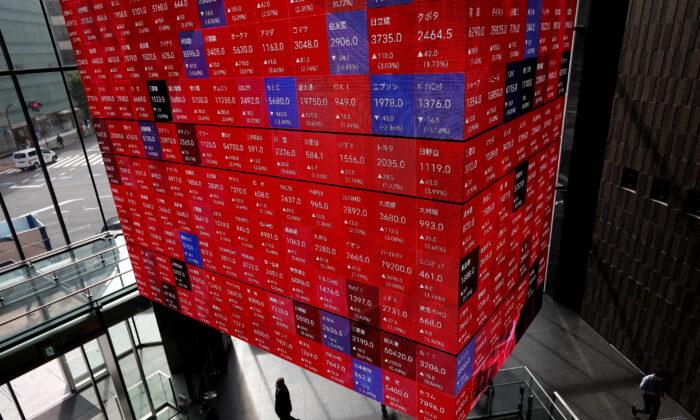TOKYO—Asian shares took a beating on Friday after a fresh salvo of hawkish remarks from Federal Reserve officials solidified expectations that U.S. interest rates could rise as soon as March, leaving markets braced for tighter monetary conditions.
Fed Governor Lael Brainard became the latest and most senior U.S. central banker on Thursday to signal that rates will rise in March to combat inflation.
Equity markets turned deeply red with investors seeking shelter in safer assets such as government debt.
MSCI’s broadest index of Asia-Pacific shares outside Japan shed 0.8 percent in mid-morning trade, while Australia lost 1.2 percent and Japan’s Nikkei shed 1.9 percent by the midday break.
South Korean shares dropped 1.5 percent after its central bank raised its benchmark rate 25 basis points to 1.25 percent on Friday, taking it back to where it was before the pandemic as it seeks to restrain consumer price rises.
China’s blue-chip index was down 0.3 percent and Hong Kong’s Hang Seng index was off 0.6 percent.
“Everyone is really nervous right now. It’s because everything is potentially going to come under pressure from aggressive Fed policy,” said Kyle Rodda, a market analyst at IG in Melbourne.
“There’s the hope that it'll be a slow and painless handoff to normal policy,” he added. “But that’s not necessarily assured with the Fed taking inflation so seriously.”
Fed Governor Christopher Waller, who has repeatedly called for a more aggressive response to high inflation, later on Thursday said a rapid-fire series of four or five U.S. rate hikes could be warranted if inflation doesn’t recede.
Shift to Safety
In the bond market, yields on 10-year U.S. Treasury notes were at 1.725 percent, slowly creeping up to Monday’s near two-year highs, signaling investors’ preference for the safety of government debt over volatile technology and growth stocks.Japan’s 10-year government bond yield hit as high as 0.156 percent, its highest since March 2021.
Markets were facing a more persistent risk of growing demand for safe-havens, especially around key events involving U.S. central bank policy and U.S. data, IG’s Rodda said.
“This is a problem because every asset has arguably been inflated by loose monetary policy,” he added.
“Every asset will have to correct to reflect higher or tighter monetary policy.”
The Fed’s hawkish shift has tended to benefit the U.S. dollar, though it did not catch much of a bid on Friday, losing ground against the Japanese yen, which traditionally has drawn demand from flights to safety.
The dollar index was flat at 94.767, settling above a two-month low of 94.660 hit on Thursday and trading in a tighter range after three days of sharper falls.
The euro bounced to $1.1464, hovering near its two-month high of $1.1481.
The Japanese yen found a bid amid the risk-off mood, trading at 113.85, near its strongest level against the greenback in 3.5 weeks.
In commodity markets, gold was a shade firmer at $1,823 an ounce but still below its January peak at $1,831.
Oil prices edged lower as investors took profits after two days of gains amid fears of aggressive U.S. interest rate hikes, though the losses were partly offset by hopes of strong demand in a tightly supplied market over the longer term.
Brent fell 27 cents to $84.20 a barrel, while U.S. crude lost 43 cents to $81.69.





